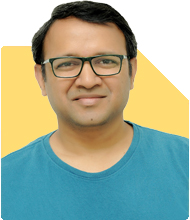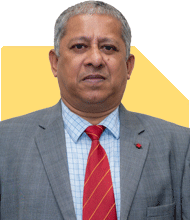Ramalingam Kalirajan |9255 Answers |Ask -Follow
Mutual Funds, Financial Planning Expert - Answered on Jun 16, 2025
He has an MBA in finance from the University of Madras and is a certified financial planner.
He is the director and chief financial planner at Holistic Investment, a Chennai-based firm that offers financial planning and wealth management advice.... more

Dear Sir, Please find below my financial details. Kindly advice further for wealth creation. PPF 10 Lacs LIC Jeevan Anand 6 Lacs RD 2000 per month Fixed Deposit 3.75 Lacs SBI- Small Cap 4000 Per month ( for 3 Years) Axis Blue chip 3000 Per month ( For 3 Years) Canara Robeco Blue Chip 3000 Per month ( For 1 Year) Mirae Asset Blue chip 4000 per month for 3 years) Medical Insurance 5 Lacs Term Insurance 50 Lacs Home Loan 28 Lacs( started in april25). Paying 8K per month extra except EMI). Property is rent out. Regards Ankur Gupta
Emergency Fund
You haven't mentioned a separate emergency fund.
Emergency fund is essential before investing.
It should be at least 6 months’ monthly expenses.
Include EMIs, insurance, household, and medical costs.
You can use a savings account or liquid fund for this.
Do not use fixed deposits or mutual funds for this.
Keep this fund easily accessible.
Life Insurance and Health Cover
Your term insurance of Rs 50 lakhs is a good start.
But it may be on the lower side.
Cover should be 15–20 times your annual income.
LIC Jeevan Anand is a traditional plan.
These plans give low returns and poor liquidity.
It mixes insurance with investment.
It is better to have pure insurance and invest separately.
You can surrender this LIC plan.
Reinvest proceeds in mutual funds via regular plans through CFP.
You have Rs 5 lakh medical insurance.
This is fine if employer also gives coverage.
If not, increase it to Rs 10–15 lakhs.
Add a top-up health plan for better coverage.
Health costs are rising fast every year.
Loan and Property
Your home loan of Rs 28 lakhs is manageable.
You are paying extra Rs 8000 per month, which is good.
This helps reduce interest and tenure.
Since property is rented out, income supports EMI.
But do not rely on rental for wealth creation.
Real estate gives poor liquidity and high maintenance.
Instead, increase allocation to financial assets.
You can continue prepaying loan if no better options available.
But balance between loan repayment and investment is key.
Fixed Deposit and Recurring Deposit
You have Rs 3.75 lakhs in fixed deposit.
You invest Rs 2000 per month in RD.
These are very low-yield products after tax.
Returns may not beat inflation.
Use these only for short-term goals.
For long term, prefer mutual funds.
Shift RD to a Systematic Investment Plan (SIP) in equity funds.
Keep FD only as part of emergency fund or short-term goals.
PPF – Public Provident Fund
Your PPF balance of Rs 10 lakhs is very good.
It is safe and tax-free.
It gives fixed returns and supports retirement.
Continue PPF for long term stability.
Avoid using this for mid-term goals.
But don’t depend only on PPF for retirement.
It gives lower returns than equity in long run.
Use it as a supporting instrument, not the main one.
Mutual Fund Investments
Your SIPs in multiple funds show good intent.
Monthly SIPs total Rs 14,000.
You are investing in both large cap and small cap.
SIPs are a smart way to build wealth.
Here are a few suggestions:
You are investing in four equity mutual funds.
Three are large cap or blue chip. One is small cap.
Do not invest in too many similar funds.
Large cap funds usually move in same pattern.
This leads to over-diversification with no added benefit.
Instead, choose one or two quality diversified funds.
Keep small cap fund for long term only.
Small caps are risky and volatile in short term.
Do not choose index funds.
They simply copy the market index.
They do not manage risk during market falls.
Actively managed funds are better in Indian market.
Fund managers pick quality stocks and reduce downside.
Active funds give better returns if selected with care.
Also, avoid direct mutual fund plans.
They may look cheaper, but come without proper guidance.
Many investors make emotional decisions in direct plans.
They miss rebalancing and portfolio correction.
Invest through regular plans via MFD who is also a CFP.
You get proper advice, reviews, and rebalancing support.
Good advice helps you avoid costly mistakes.
Investment Strategy – Next Steps
You can now structure your financial plan like this:
Short-Term Goals (0–3 years)
Keep emergency fund of at least 6 months’ expenses.
Use liquid fund or FD for upcoming expenses.
Do not invest this amount in equity mutual funds.
Medium-Term Goals (3–7 years)
Use hybrid mutual funds or balanced advantage funds.
These reduce risk with equity and debt mix.
You can invest some of the FD here.
Long-Term Goals (7+ years)
Use equity mutual funds – large, flexi-cap, small cap.
Do SIPs regularly and increase yearly if income rises.
Stick with long term. Don’t stop during market fall.
Tax Planning and Returns
PPF is already helping in 80C tax saving.
LIC also helps but with low return. Better to surrender it.
SIPs in equity mutual funds are tax-efficient.
New tax rule for mutual funds is now different:
Equity LTCG above Rs 1.25 lakhs is taxed at 12.5%.
Short-term gains are taxed at 20%.
Debt fund gains taxed as per income slab.
Avoid FD as main investment. It gives fully taxable return.
Mutual funds are better after tax adjustment.
Retirement Planning
You are doing some investments but not enough for retirement.
You must plan retirement early for compounding.
PPF is safe but not enough. Use equity mutual funds more.
Estimate your future needs with a financial expert.
Invest with clear goal and timeline.
Child’s Education or Other Goals
You have not mentioned children or specific goals.
Start planning even if child is small.
Education inflation is very high.
Use SIPs in mutual funds for such goals.
Key Action Plan for You
Create emergency fund first. Use FD or liquid fund.
Surrender LIC Jeevan Anand. Invest money in mutual funds.
Stop RD. Start SIP of same amount in balanced mutual fund.
Continue SIPs. Reduce to 2–3 quality funds only.
Invest only through regular plans with CFP-led MFD.
Don’t choose direct plans or index funds.
Keep paying extra to home loan. But balance with investments.
Increase term insurance to at least Rs 1 crore.
Increase health cover with top-up plan.
Track all investments and goals annually.
Finally
You have started well. Your savings habit is good.
You are investing regularly and taking insurance protection.
But your portfolio needs better structure and focus.
Avoid mixing insurance and investment.
Avoid low return products for long term goals.
Use equity funds more through regular plans with CFP support.
Stick to plan for 10–15 years for wealth creation.
Do not panic during market falls. Stay invested.
Rebalance portfolio yearly with professional help.
Best Regards,
K. Ramalingam, MBA, CFP,
Chief Financial Planner,
www.holisticinvestment.in
https://www.youtube.com/@HolisticInvestment
You may like to see similar questions and answers below
Ramalingam Kalirajan |9255 Answers |Ask -Follow
Mutual Funds, Financial Planning Expert - Answered on Jul 29, 2024
Ramalingam Kalirajan |9255 Answers |Ask -Follow
Mutual Funds, Financial Planning Expert - Answered on Aug 28, 2024
Ramalingam Kalirajan |9255 Answers |Ask -Follow
Mutual Funds, Financial Planning Expert - Answered on May 29, 2025
Patrick Dsouza |1199 Answers |Ask -Follow
CAT, XAT, CMAT, CET Expert - Answered on Jun 28, 2025
Patrick Dsouza |1199 Answers |Ask -Follow
CAT, XAT, CMAT, CET Expert - Answered on Jun 28, 2025
Patrick Dsouza |1199 Answers |Ask -Follow
CAT, XAT, CMAT, CET Expert - Answered on Jun 28, 2025
Patrick Dsouza |1199 Answers |Ask -Follow
CAT, XAT, CMAT, CET Expert - Answered on Jun 28, 2025
Patrick Dsouza |1199 Answers |Ask -Follow
CAT, XAT, CMAT, CET Expert - Answered on Jun 28, 2025
Patrick Dsouza |1199 Answers |Ask -Follow
CAT, XAT, CMAT, CET Expert - Answered on Jun 28, 2025
Prof Suvasish Mukhopadhyay |1858 Answers |Ask -Follow
Career Counsellor - Answered on Jun 27, 2025
Prof Suvasish Mukhopadhyay |1858 Answers |Ask -Follow
Career Counsellor - Answered on Jun 27, 2025
Prof Suvasish Mukhopadhyay |1858 Answers |Ask -Follow
Career Counsellor - Answered on Jun 27, 2025
Prof Suvasish Mukhopadhyay |1858 Answers |Ask -Follow
Career Counsellor - Answered on Jun 27, 2025





















